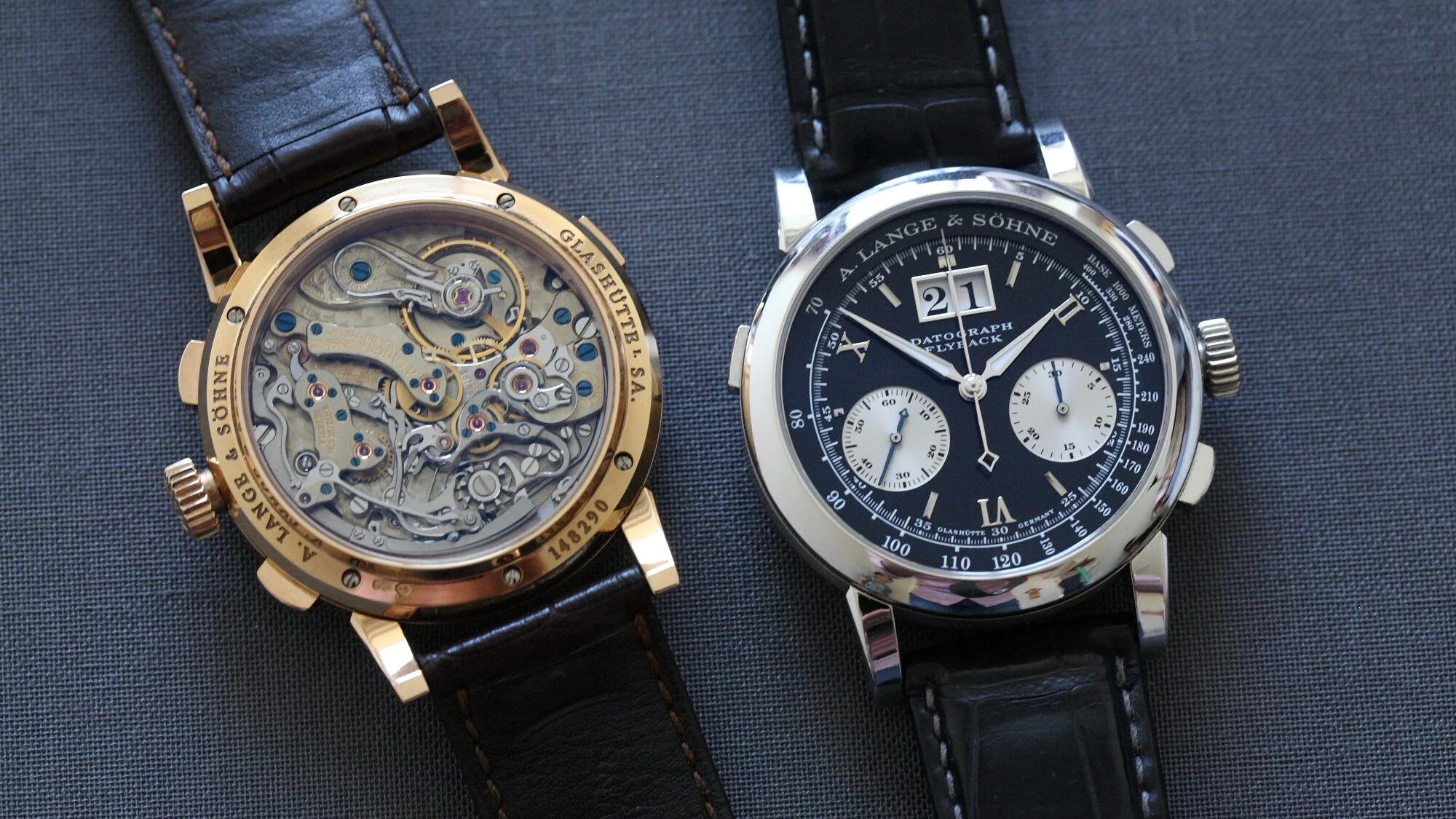
A. Lange & söhne Datograph
The Collector’s Guide – May 2020
Updated April 2024
Introduced in 1999, only 5 years after A. Lange & Söhne introduced its first collection in 1994, the Datograph (Dat(e) + (Chron)ograph) is one of the first in-house developed chronograph wristwatches following the quartz crisis. It was in production for 12 years from 1999 to 2012 up until the introduction of the Datograph Up/Down. The Datograph is particularly famous for its movement architecture, finish and unconventional dial and case design. It was graced by none other than Philippe Dufour in 2007 as “the best chronograph movement ever made”. If it is good for Monsieur Dufour, who owns one example in pink gold with black dial, it is good enough for any watch enthusiast.
Quick Facts:
- Introduced in 1999
- Available in platinum, gold
- Available with bracelets
- Offers collectable references, generational differences
- Production number across all metals said to be around only about three thousand
- Updated in 2012 with the introduction of the Datograph Up/Down
During its centuries of existance, the watch industry went through several paradigm shifts. It went from being utilitarian to functionally obsolete to luxurious, and as claimed today; art pieces and status symbols boasted with provenance and stories. Inevitably, the hardware part of the industry, the watchmaking also followed. It transitioned from putting out fundamental inventions where one could see their value with observatoire competitions and finally to gimmicky innovations to open up new markets and attract attention…
In focus, one of the latest shifts within the industry was without a doubt the in-house trend that took place during the last 20 years; where the traditional Swiss style outsourcing components left its place to vertical integration. We started to hear almost every manufacturé introducing so-called in-house movements; which actually a considerable amount is the same movement with different brand stamps…
However, as Newton explains in his first law of motion: an object will not change its motion unless a force acts on it. Among many forces for the in-house production shift, there was a crucial one from a small town in Germany and this is its story: Datograph.
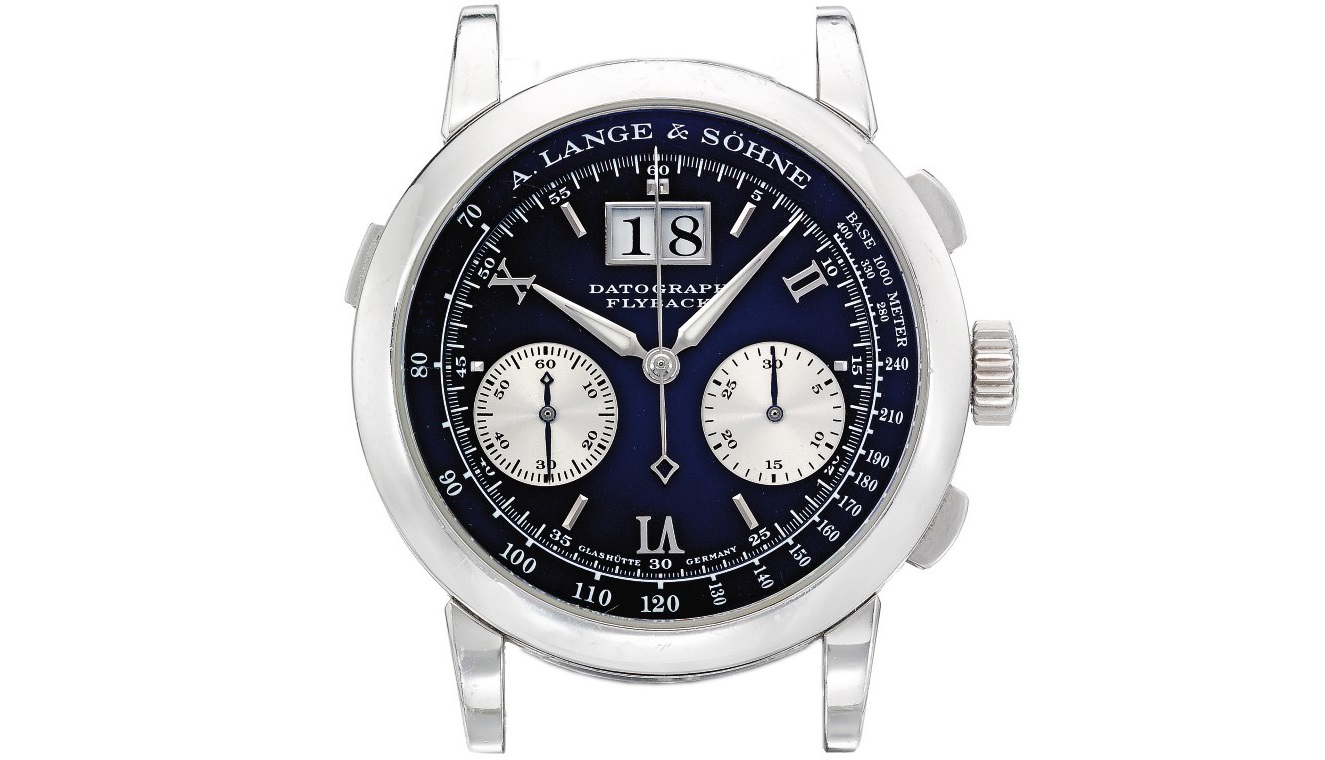
The Beginnings
A. Lange & Söhne came up with Tourbillon Pour le Mérite in 1994; signalling that it wants to fight for the highest echelon of complicated watchmaking. Yet, one hit wonders do not work and there are some quintessential complications a manufacture has to master in order to gain a presence in the broader market. One of those complications is, without a doubt, the chronograph.
In the famous business book Positioning – The Battle for Your Mind Jack Trout and Al Ries talks about a concept called Product Ladder. Basically; each step of the ladder is a brand name and each different ladder represents a different category. So, if you are late to the market as A. Lange & Söhne ws, you need to compete with an already established ladder in the prospect’s mind.
Now, please try to apply the product ladder theory to the watch industry and prospects’ state of mind during 1990s. Who do you have in mind when one speaks about a chronograph? Patek Philippe, Vacheron Constantin, Audemars Piguet etc. the usual suspects. Hence, for A. Lange & Söhne to step-out from such established competition from product point of view there was only one way out: Create your own ladder or disappear.
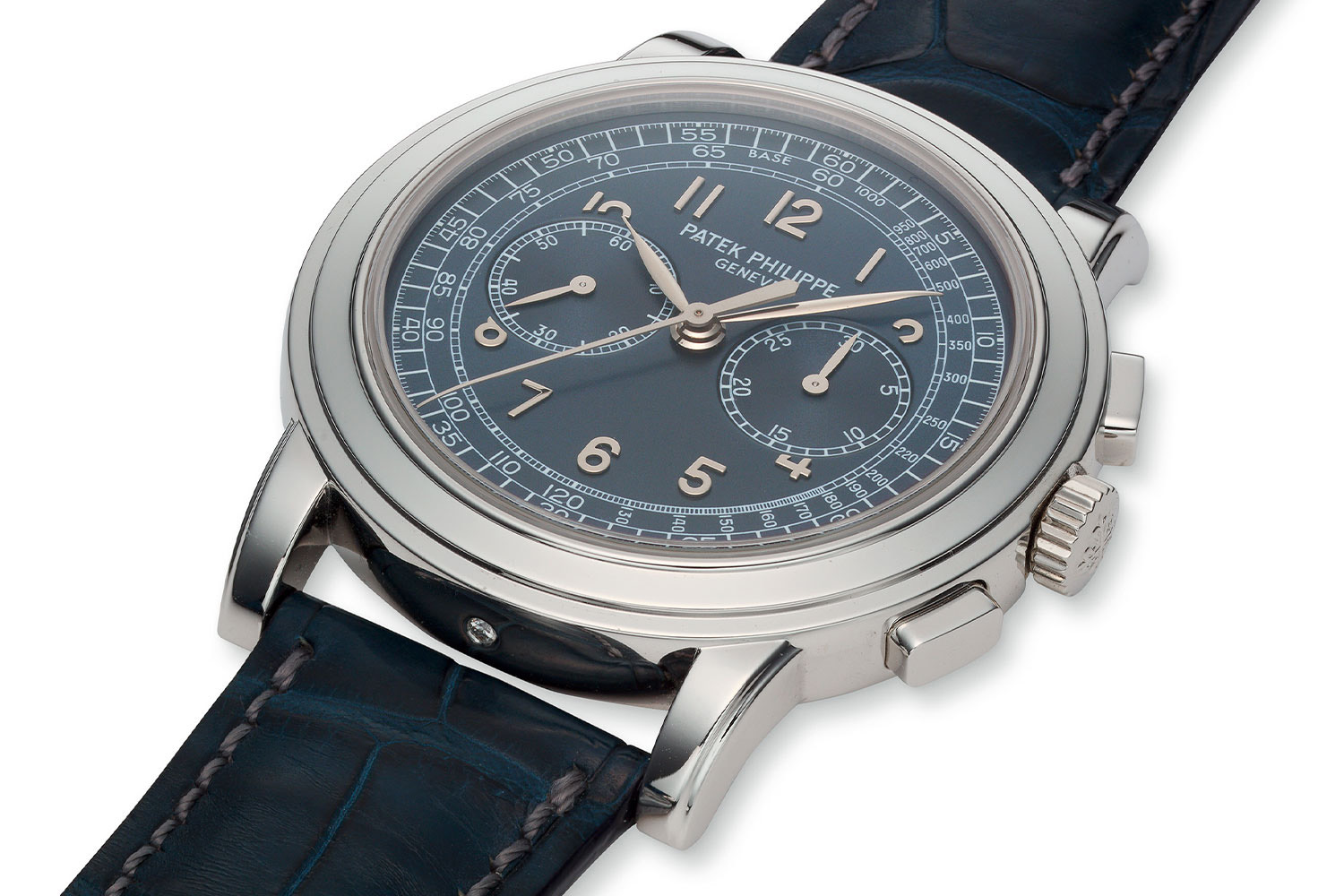
The legend Patek Philippe 5070P. Courtesy of Collectability.com of John Reardon.
Creating a ladder however is not an easy feat. A. Lange & Söhne needed to take a different approach to almost everything, except the established dominant design features such as chronograph registers, or pushers, tachymeter scale… But everything else had to be reconsidered. And A. Lange & Söhne found the area that it wanted to focus – it was not on the front, but hidden for connoiseurs.
In 1999 at the the turn of the century, after decades passing by without a new chronograph movement, a company that was merely 9 years old came up with the most unexpected – an in-house chronograph: caliber L951.1 of the Datograph Flyback. The in-house chronograph of such magnitude, architecture and finish was the new ladder. Just to make it more concrete, in 1998, Patek Philippe had just introduced the 5070 with the Lemania ebauche (which is also too small for the case).
A note 17/02/21: Jaeger-LeCoultre’s Kaliber 829 preceeds the L951.1 by a year. Thank you @so.frech for the correction.
This is the watch that got me into watchmaking (no it was not my grandfather) more than a decade ago, and since then, it delivers the same excitement, everytime.
1999 Basel
Franken words are one of the most well-known linguistic practices in German. These are the words that are formed by the combination of couple of words such as, Fingerspitzengefühl – Finger/Spitzen/Gefühl. So, as a German company, Lange also followed the language and created the name Datograph – Date + chronograph.
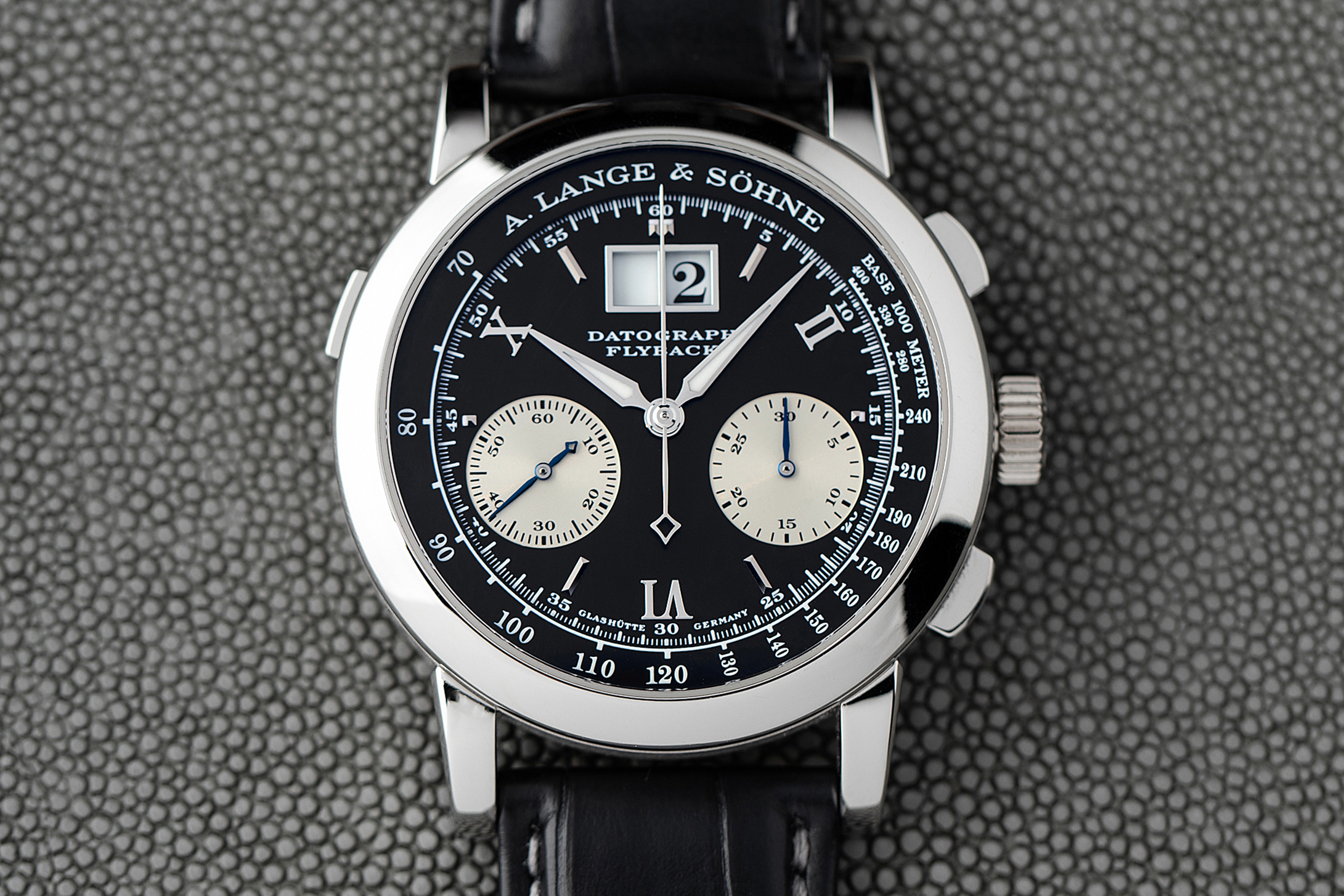
403.035F. Courtesy of WatchBox.
Lange introduced the Datograph in platinum reference 403.035 at Basel Fair in a small, shared booth with siblings IWC and JLC in 1999. There was not a giant watch in the booth, as it is the tradition now; but a giant movement model, just to increase the rushing heartbeat of the Swiss Competitors and to give them the opportunity to closely examine what they would have to deal with. Michael Hickcox, a well known collector and a dear friend says:
“A. Lange & Söhne Datograph changed the future of watchmaking right there and then.”
First generation Datograph was produced between 1999 and 2011. Before diving deep into the watch itself, I’d like to talk about the specifications of the models and the Datograph’s production numbers.
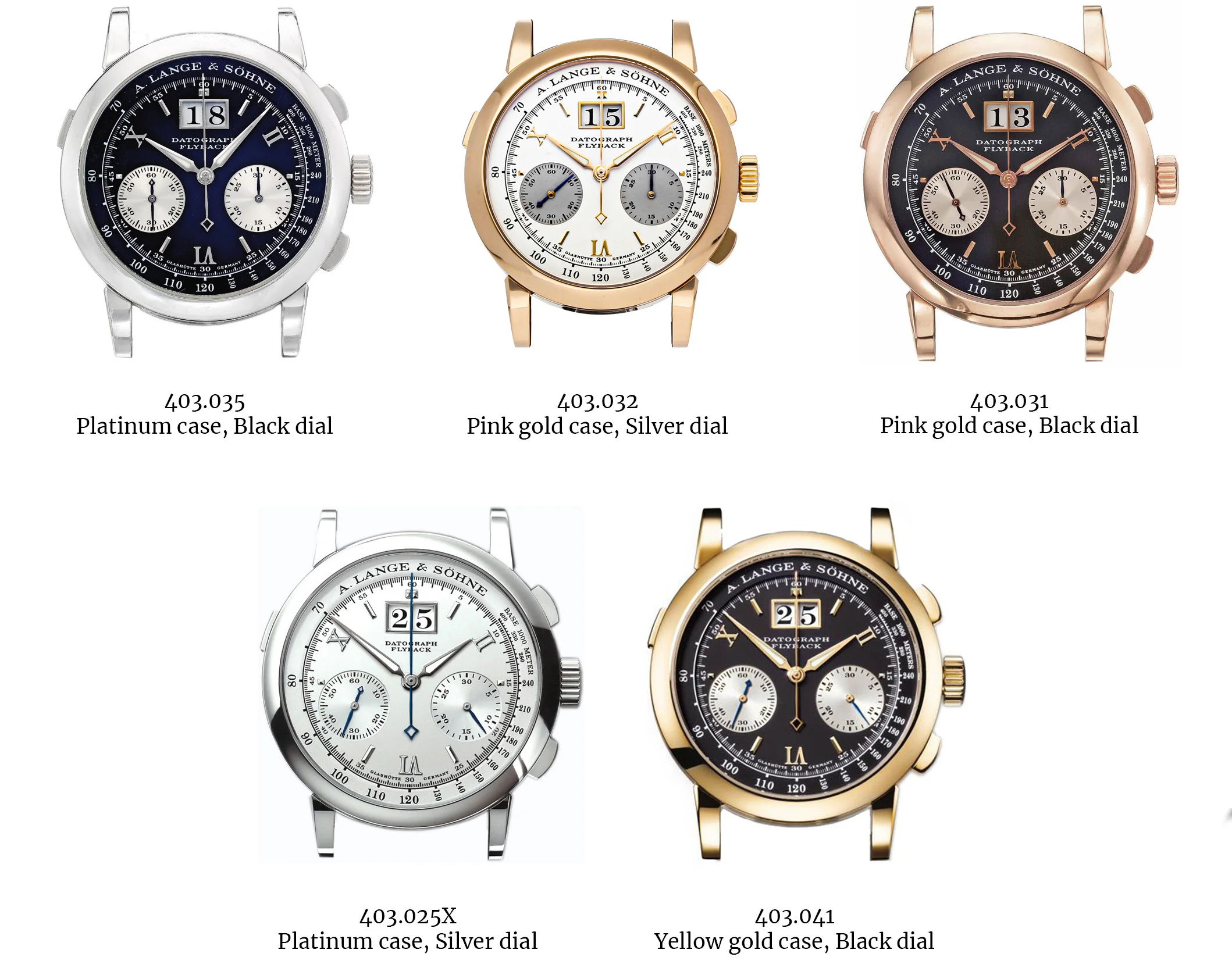
The platinum Datograph with black dial, both due to being the first one and the most common version, is the face of the collection. Though please note that even if the reference was produced for 12 years, when you take Lange’s production numbers (5k pieces at most in those years) in account, and other chronograph watches such as Double Split that would divide the production, it is considerably rare compared to most other brand’s flagship products. My educated guess would be in between 2000-2500.
On the other hand, the rightfully famous Dufourgraph reference 403.031 was produced only for about 2 years between 2003 and 2005. The reference takes its moniker from Mr. Philippe Dufour, who repeatedly stated that the Datograph is the best chronograph ever made, which he owns one in pink gold.
Among the usual three, I’d claim that the reference 403.032, pink gold / argenté dial is the underrated one. If Datograph collection would be Metallica, this one would be the Jason Newsted of the group. No less talented, yet overshadowed by its predecessor. Indeed, the original platinum / black dial Datograph plays a huge part in the 403.032‘s inpopularity; because people think that the black dial version is the one to have for collectability purposes. It is true to some extent, however, the 403.032 is no less beautiful. In fact, in comparison, it is much more sober and present; hence it certainly lures its own crowd.
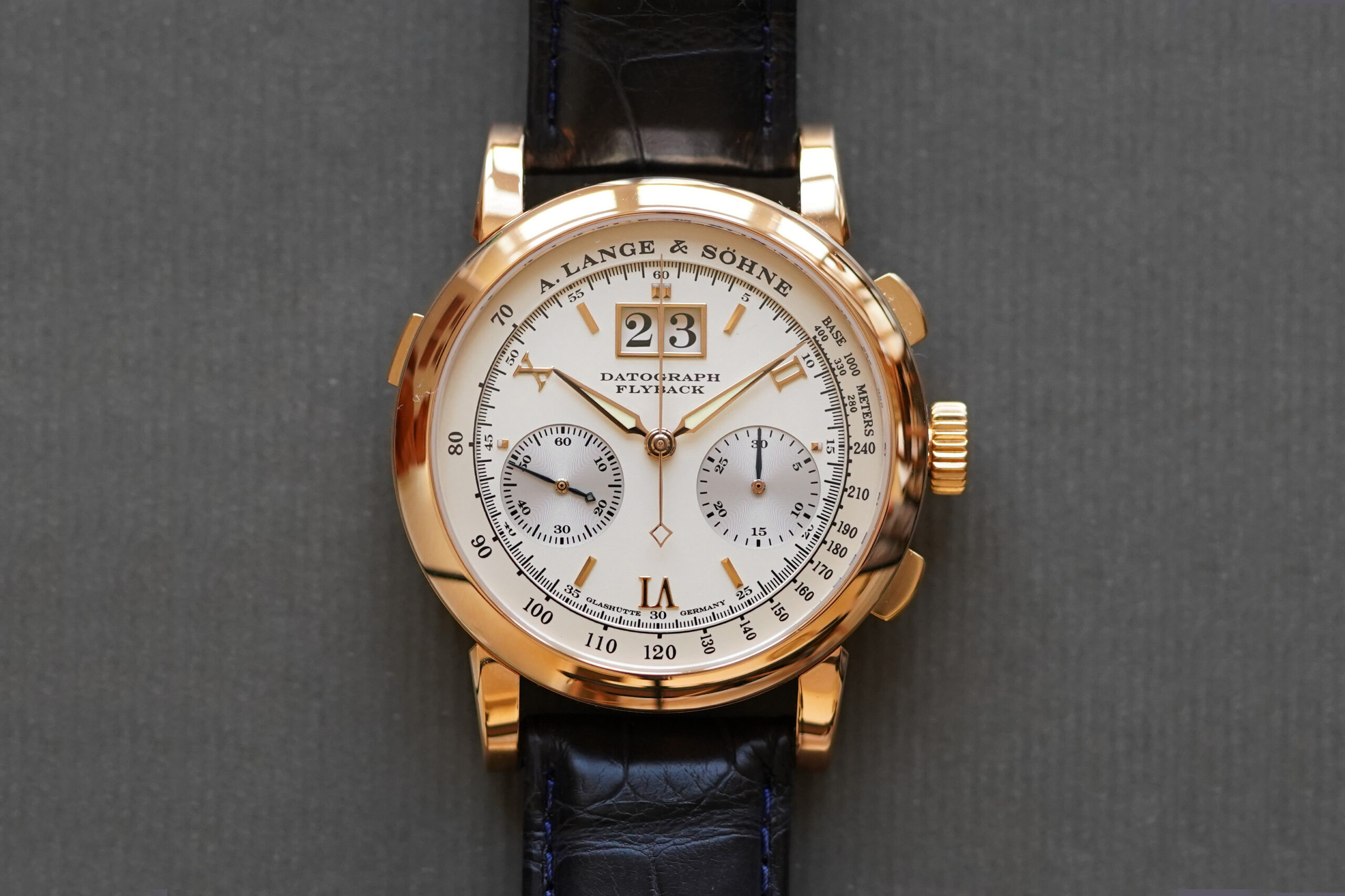
The delightful 403.032. Courtesy of my friend @dr.ho.rology
Another important reference is the yellow gold Datograph (ref. 403.041 – aka Yellow Jacket) which was produced circa in 2008 with an estimation of 50 pieces in total. It has an interesting story: During SIHH 2008, the executives wear the yellow gold Datograph on the wrist for testing the public opinion purposes; as they still do from time to time. As a result the watch never appears in the catalogues and only sells via private relationships. This important reference made its public debut for the first time in Phillips Watches Retrospective Auction and sold for over CHF 170k.
Lange also made couple of special editions for executives with full black, blue and silver dials. In addition, as a common practice of early days, the brand launched a special edition Datograph for the infamous retailer Pisa Orologeria in Milan in a limited edition of 10 pieces – graced with a platinum case and a silver dial. If you ever see one of these available, please pull the trigger faster than Red-Kit as they do not linger around much – or better, let me know.
Now, let’s dive deep into it.
Datograph Case – A Hockey Puck?
Coming from the positioning notion mentioned above; the brand’s co-founder Günter Blümlein was aware that everything must be aesthetically pleasant and distinctive to create a unique position in the crowded marketplace. Therefore, he started with the cases, wanted them to reflect the Teutonic, strong identity of the region with heft. He said; When handling our watches, I want the owner to get the feeling of closing the door of a Mercedes. Walt Odets, as he does to many things, explains this the best:
“It was (Saxonia 34 mm case) twice the weight a gold watch its size ought to be. The buckle was twice the weight it ought to be. Even the sapphire back had more gold in it than two solid backs from anyone else.”
However, for Datograph, the current round case was not the first choice of Reinhard Meis, chief designer at the time and one of the world’s foremost watch historians, and Blümlein. There was another design that ignited the fire of Datograph towards the end of 1993: A tonneau shape. Indeed, as you might understand, Datograph’s famous movement was designed later on according to the decided case and dial design.
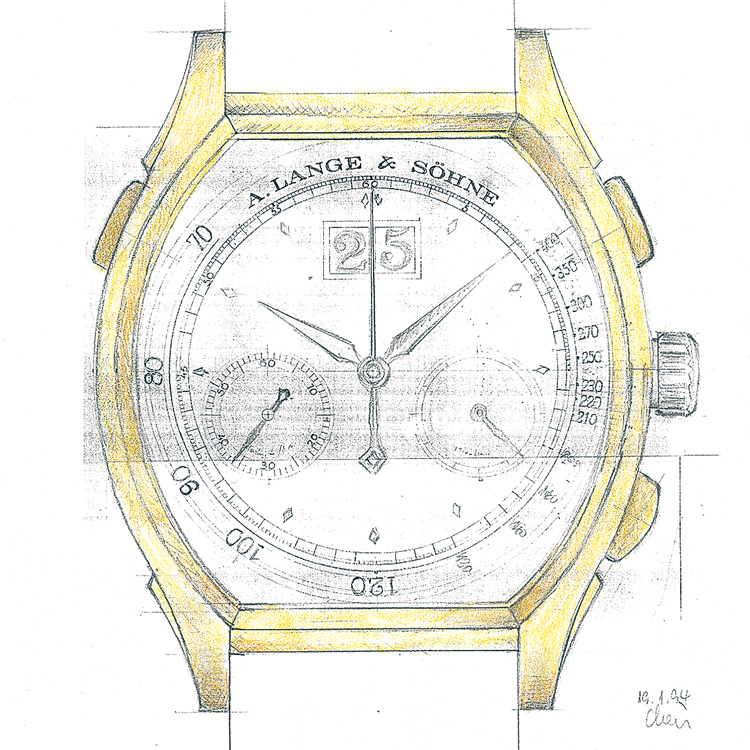
Even though the case shape is different, please note that the lugs, proportions, hands, and that famous triangle formed by sub-dials and big date are exactly the same. This was the template that later gave birth to the legendary caliber L951.1. Also note that the work started all the way in 1994. To be honest, I would’ve loved to see this! Perhaps for the 25th year of Datograph as 25 pieces?
The first generation Datograph case measures 39 mm in diameter and a relatively hefty 12.8 mm in thickness. When you strap the watch, the density and weight of the platinum case is immediately there. Yet, upon enjoying it for some time, its solid feeling creates a dangerous addiction – causing many other pieces to feel hollow.
It is constructed on three different levels as the case back ring, case band and bezel. The case band is satin-finished and beautifully contrasts against the mirror polished parts. The pushers have fine bevels and gracefully polished.
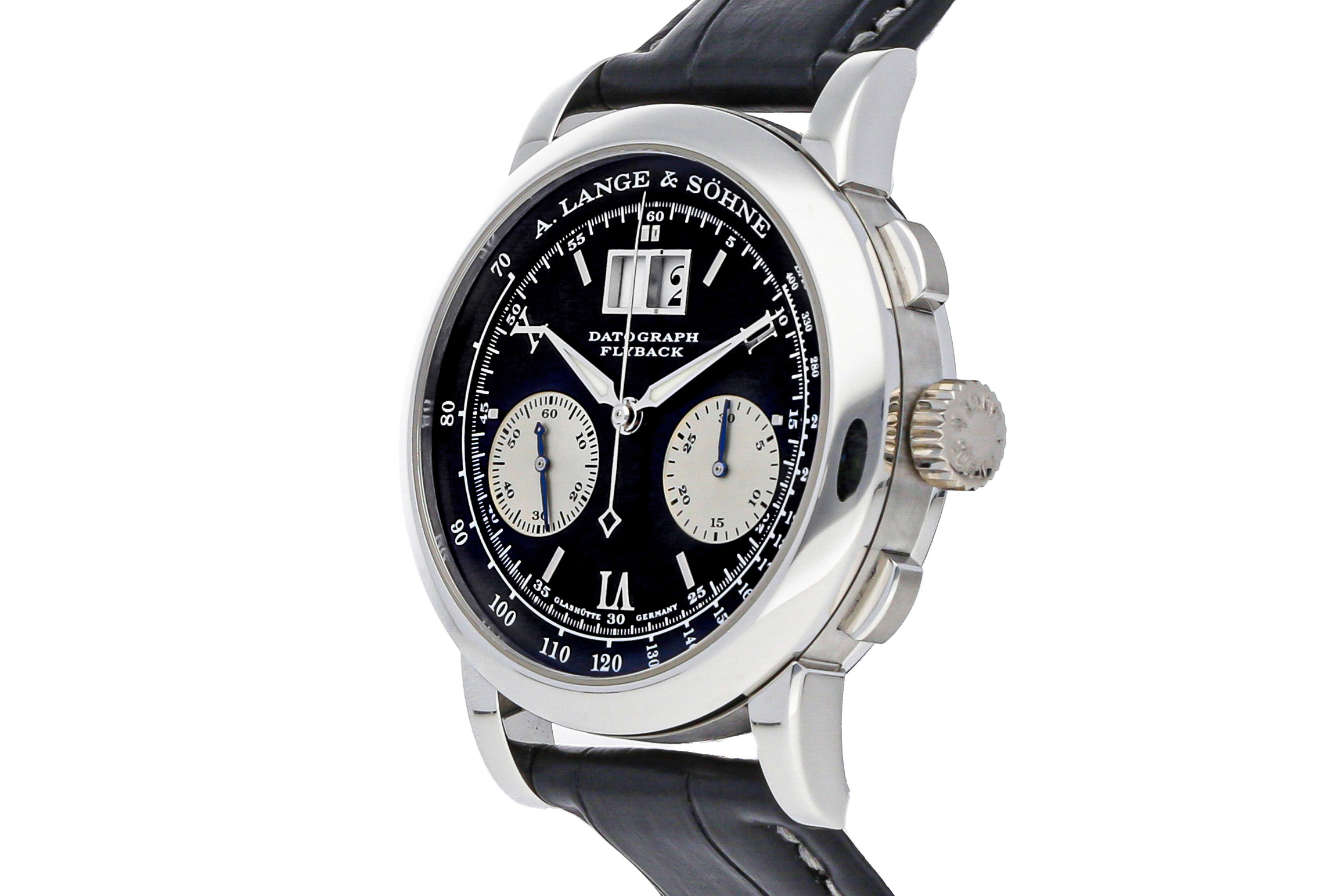
Three-step construction with signature details such as the angular and notched lugs
As it is the case with most thick Lange watches, the case back is slightly raised then drops towards the sides. It is there to accommodate the movement but also a visual trick of thinness when observed from the sides. I must add that due to this design feature, sometimes, the watch does not sit right on the wrist.
The main differentiator however is the lug design. Upon carefully examining the point where lugs meet with the case, you are going to notice a notch. That notch, thus the lugs, is one of the characteristic elements of Lange cases, not given up even for the Odysseus. The idea was developed by Blümlein to individuate the cases compared to Swiss counterparts. Consequently, he asked the craftsmen to mirror-polish the notched areas. In order to achieve such a contrast, the lugs had to be separately finished.
As a result, some A. Lange & Söhne lugs are soldered into the case after finished, which in return delivers this striking detail. Moreover, the curvature of the lugs helps the watch sit comfortably on the wrist. The lug width of the series is 20mm and buckle width is 18 mms.
Datograph Dial - A Masterclass
The Lange Datograph (403.xxx series) is a lesson on constructing a geometrically harmonious design. Sure, it was odd for its time. Lowered sub-dials and Roman Numerals for a chronograph watch, and even a big date? Yet, none achieved great gains without taking great chances. Here, the blend of these strange elements created one of the most characteristic and recognizable designs in watchmaking.
A closer look reveals the very-well thought out details. The reason for sub-dials’ below the center placement is to strike a balance with the big-date window. The three indications form an equilateral triangle with a central point being the pinions in the middle; which gives a perfect focal point. Moreover, the Roman Numerals form another triangle between themselves, hence beautifully balances out the indications.
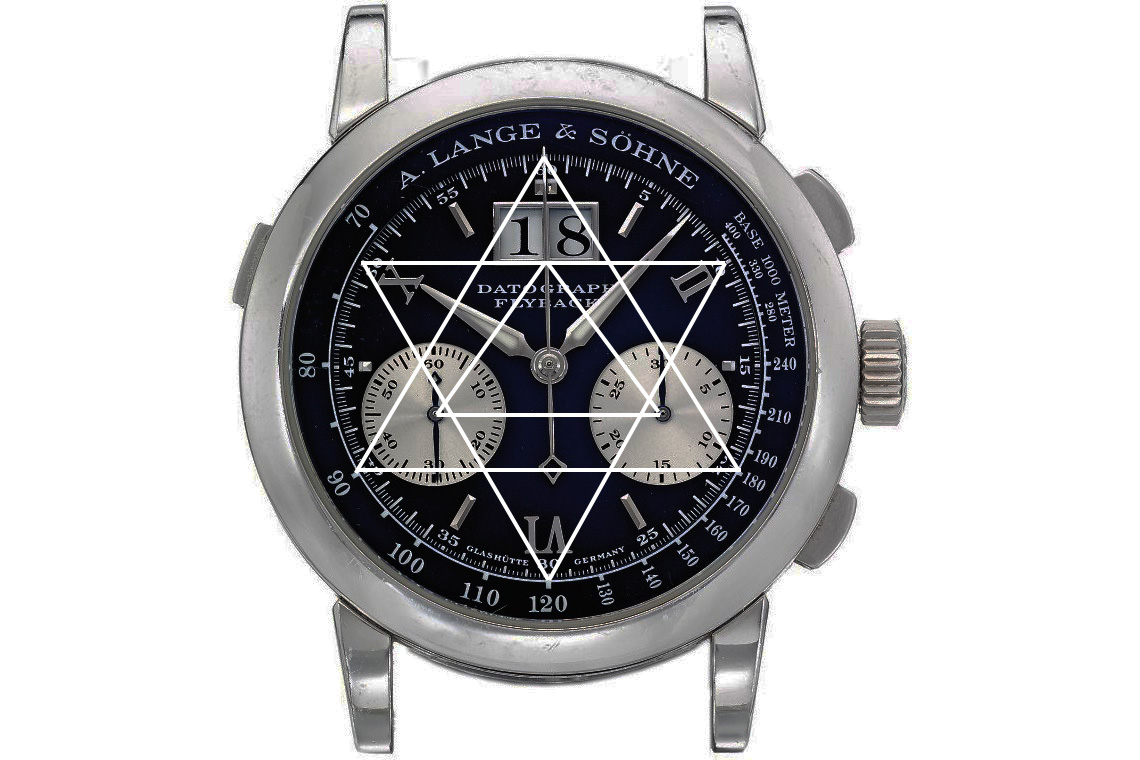
Datograph’s dial is mathematically perfect, but not without a soul. That soul reflects as strong and sturdy rather than romantic, a perfect companion to its hefty case and baroque indices. The dials are crafted from solid silver. Simple, yet exquisitely shaped baton indices tastefully complement the complexity brought by Roman Numerals. The gold hands are relatively broad and lumed, enhances legibility while contributing to Datograph’s chic-sporty look.
The big-date window frame utilizes the respective case material and handsomely polished. It is a great example on how finish contributes the functionality – as the reflection caused by polished windows illuminate the deep seated discs and delivers excellent legibility. The thick window frames also hide the leveled placement of the date discs – which is apparent in Zeitwerk models.
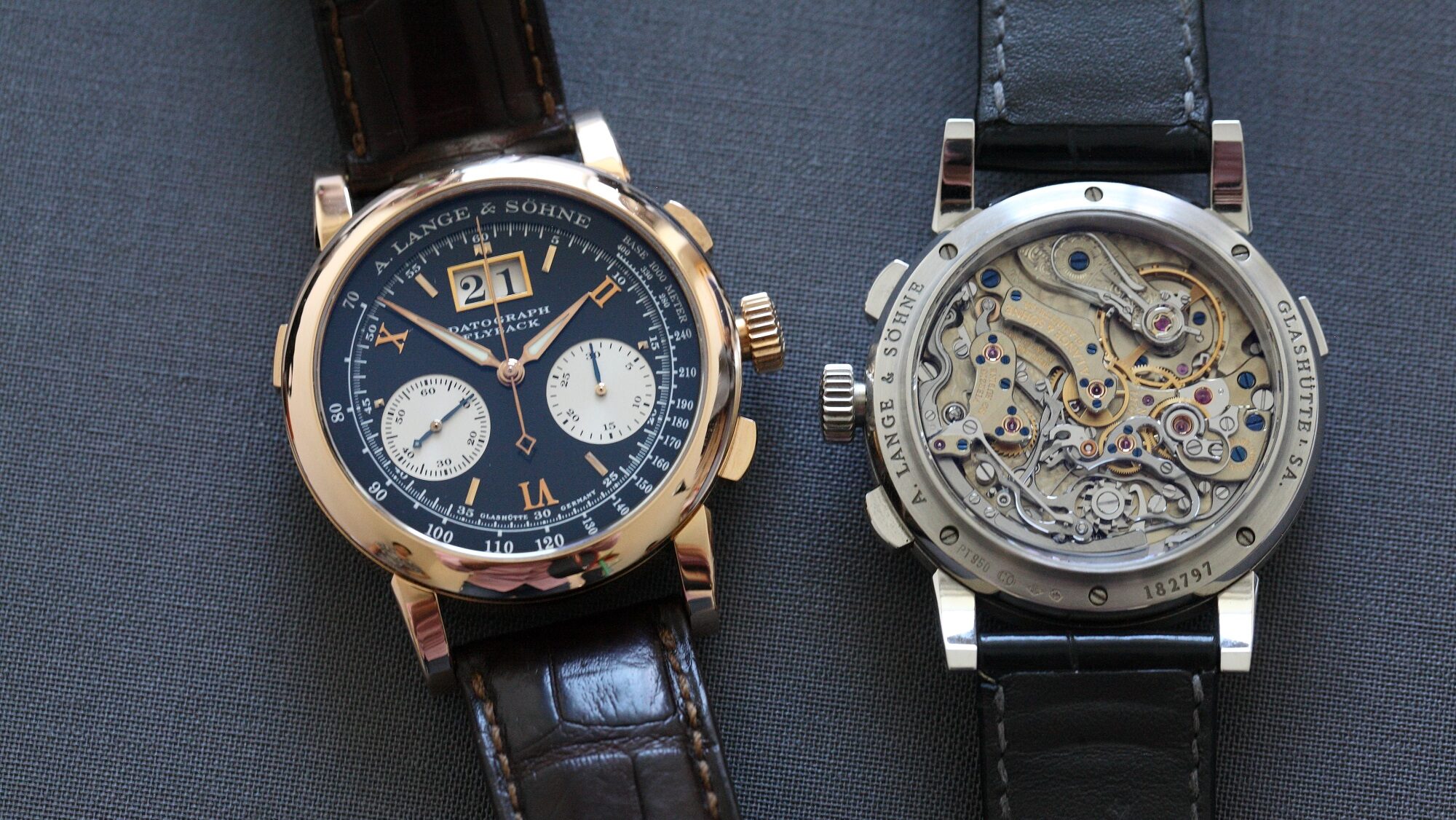
The only critique I can swing towards Datograph’s dial is regarding the date discs: When the date is between 1-9, the left window stays blank. Although this is the same for all Lange watches with big date; it disturbs when the window is in the middle, as it breaks the symmetry for 9 days.
Two quick notes:
- The date change for Datograph is gradual, not instantenous. So it is normal that your watch takes about an hour to complete the jump of the date windows.
- There are two variations as “METER” (earlier one) vs. “METERS” dials and thick print vs. thin print.
Caliber L951.1
Datograph’s movement alone deserves its own 6000+ words article. Alas, as I already rambled a lot due to my extreme – sometimes dangerous admiration for Datograph, I am going to try to keep it concise without skipping any of the anecdotes and slight changes in movement throughout its lifetime.
From the movement’s reference number L951.1, we understand that the development started in 1995. It was the first movement of the year and the first iteration of the series. The end product is a result of a couple years of design, prototyping and construction period.
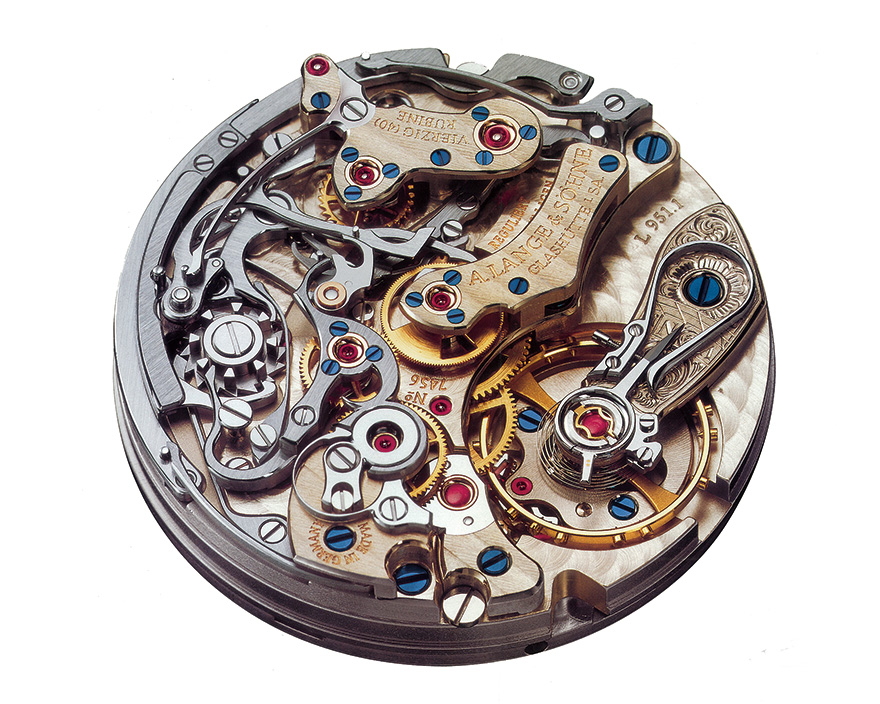
On the technical front, the caliber L951.1 is neither a groundbreaking nor an innovative movement. It is a traditionally constructed, horizontal-clutch (chronograph and running gears engage horizontally) column wheel chronograph mechanism. Nevertheless, what puts it in a different league is its incomparable depth in architecture, harmony of finish techniques, different colors and as Ray Hudson would say; exemplary curvature that can only be rivaled by Jessica Rabbit on steroids.
Before going into the depths of technicals and aesthetics, I’d like to start with the development process of this one of a kind movement.
As mentioned in the case section, Datograph’s dial design was already decided so the goal was to create a matching & functioning movement accordingly. The job was on the shoulders of the three legends who are a big part of what made A. Lange & Söhne what it is today: Reinhard Meis, Helmut Geyer and Annegret Fleischer. However, it was Meis who was involved with the movement in and out – from mechanics to aesthetics.
Coming up with any design is a rigirous process, requires draft after draft until the final decision. As one of the first drawings show, the caliber L951.1 is no exception.
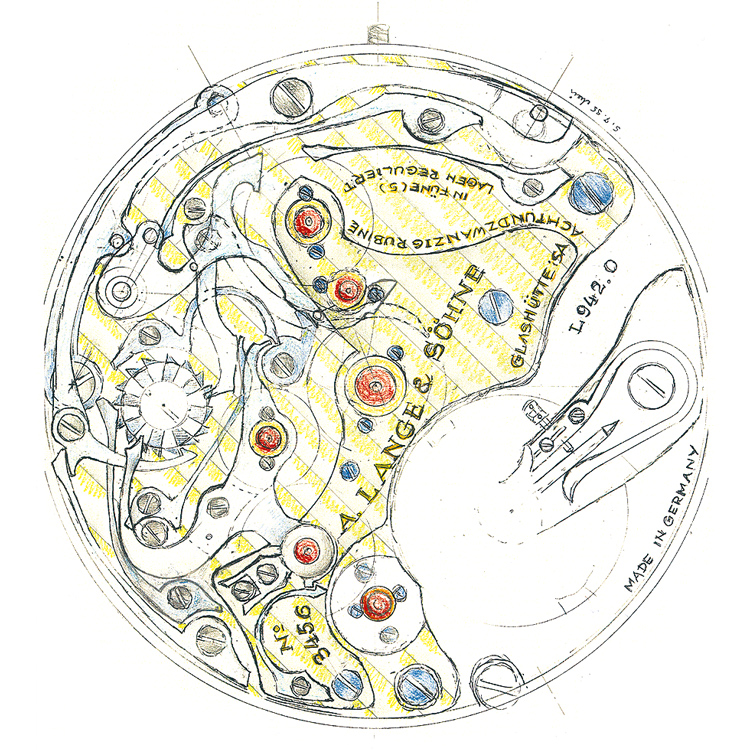
You see, even though the first design carries a great resemblance to what was going to become the Datograph, it does not have its full functionality e.g. it has the flyback lever, but not the jumping minute counter bridge. Moreover, the caliber number is L942.0 – because the idea of precise minute counter was added in 1995, which then gave the movement its final form to work on.
It took years for the two movement constructors to make L951.1 a reality. As I have heard couple of times, especially the precise minute counter needed hundreds of re-design and many solutions to make it work properly. If you’d like to read more on this particular mechanism, here is the link to the patent attained in 1998 by Reinhard Meis.. Further, it was tested by none other than Blümlein, as witnessed by Anthony De Haas.
Going Deeper Into Caliber L951
The finished movement measures 30.60 mm in diameter, 7.5 mm in thickness. It beats at a traditional 2,5Hz and delivers 36 hours of power reserve. Furthermore, the caliber L951.1 employs a flyback mechanism and a jumping minute counter. Albeit relatively common today, please note that these were very rare feats for 1999. For better understanding, neither Patek Philippe chronographs – 5070, nor Vacheron Constantin chronographs were housing such sophistication.
Before admiring and writing poetry on its beauty, first let’s try to understand how does the Datograph, hence a chronograph work.
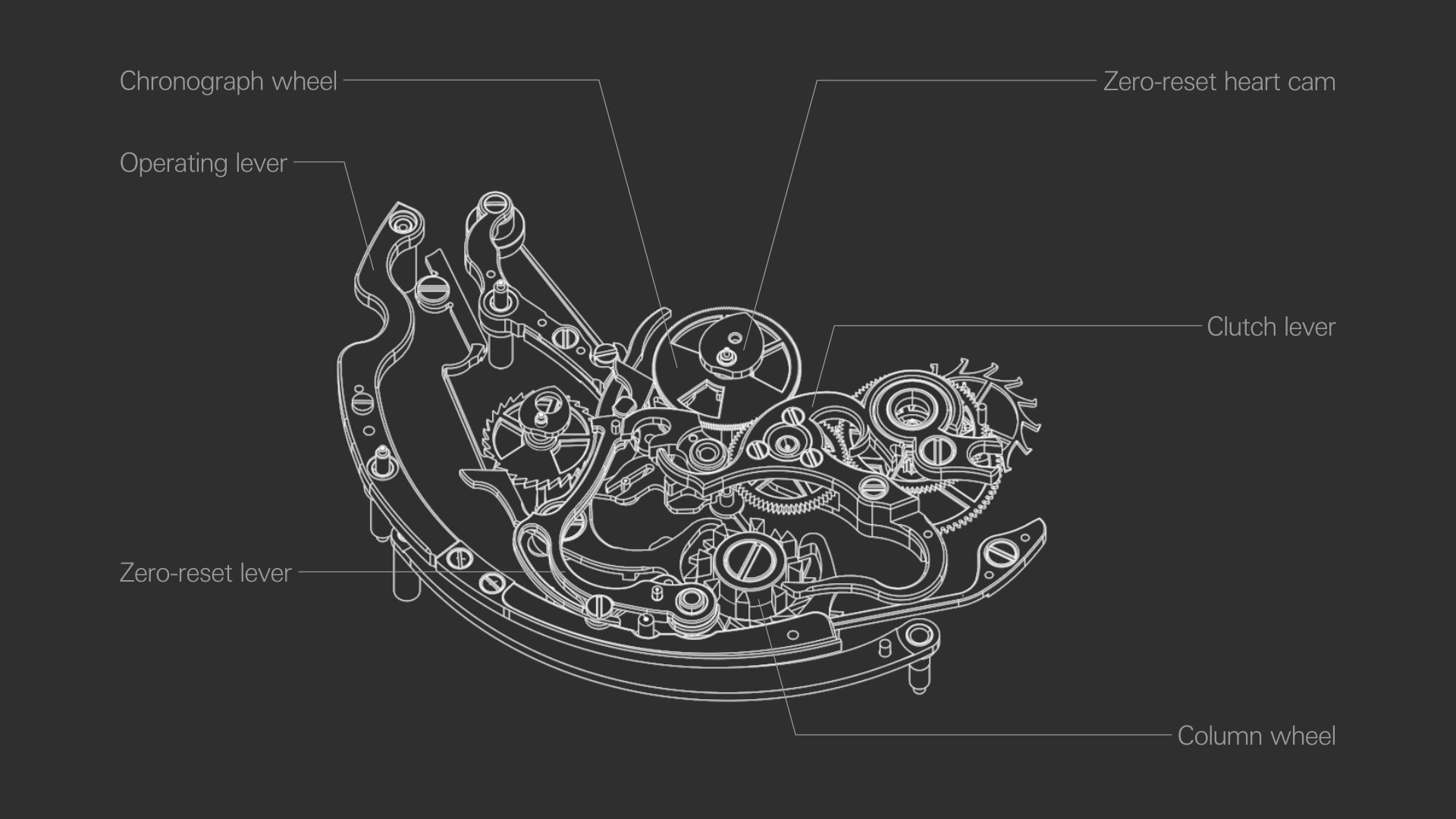
Courtesy of Lange Uhren GmbH
The processor of the caliber L951.1 is the column-wheel. It is the link between the pushers and the function we see. If you look closer, you are going to see that the clutch lever, zero-reset lever and the operating lever are all connected to it. The chronograph becomes active when the operating parts of the mechanism connects to the running movement. When the user presses the start button, column wheel spins forward and pushes the clutch lever’s tail in between the pillars. With this motion, the clutch lever moves horizontally and meshes with the chronograph wheel. To stop, pressing the button again, the clutch lever sits on the pillar again and disengages from the chronograph mechanism.
How about flyback? This mechanism makes it possible to stop and reset a running chronograph mechanism with a single pusher activation.
The two essential parts of the feature are two armed heart lever (3) and the coupling wheel (8). The process begins with the push (1) to the zero-reset lever (2). Upon pressing the button (1), the zero-reset lever is pressed downwards and a pin transfers this motion to the heart lever. The heart lever holds a pin that is in permanent contact with the claw shaped flyback lever (4). Therefore, when the heart lever is pressed downwards, it presses the flyback lever to the left; thus, the flyback lever presses the coupling wheel and detaches it from the chronograph seconds wheel (6) and stops the chronograph.
On its downward motion, the heart lever makes contact with the heart shaped cam (7). Since the cam is connected to the chronograph seconds’ wheel, when the heart lever’s tail (5) pushes the cams, the seconds hand goes back to the zero position. When the pusher is released, the heart lever is pulled upwards and the whole process starts in order.
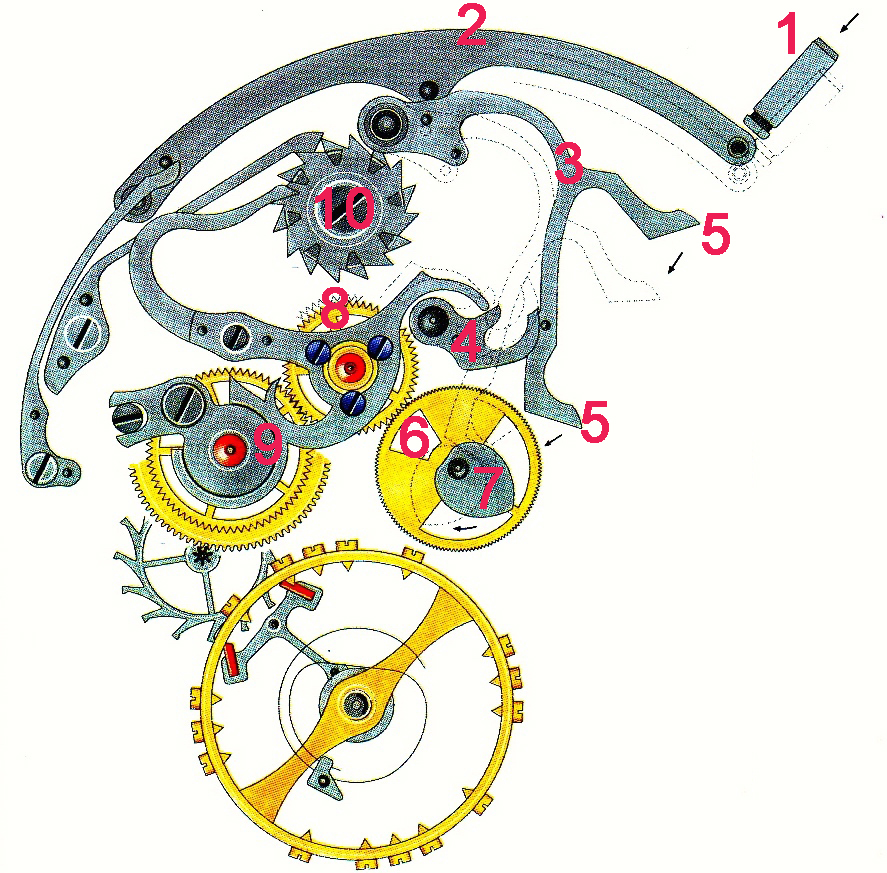

The two essential parts of the feature are two armed heart lever (3) and the coupling wheel (8). The process begins with the push (1) to the zero-reset lever (2). Upon pressing the button (1), the zero-reset lever is pressed downwards and a pin transfers this motion to the heart lever. The heart lever holds a pin that is in permanent contact with the claw shaped flyback lever (4). Therefore, when the heart lever is pressed downwards, it presses the flyback lever to the left; thus, the flyback lever presses the coupling wheel and detaches it from the chronograph seconds wheel (6) and stops the chronograph.
On its downward motion, the heart lever makes contact with the heart shaped cam (7). Since the cam is connected to the chronograph seconds’ wheel, when the heart lever’s tail (5) pushes the cams, the seconds hand goes back to the zero position. When the pusher is released, the heart lever is pulled upwards and the whole process starts in order.
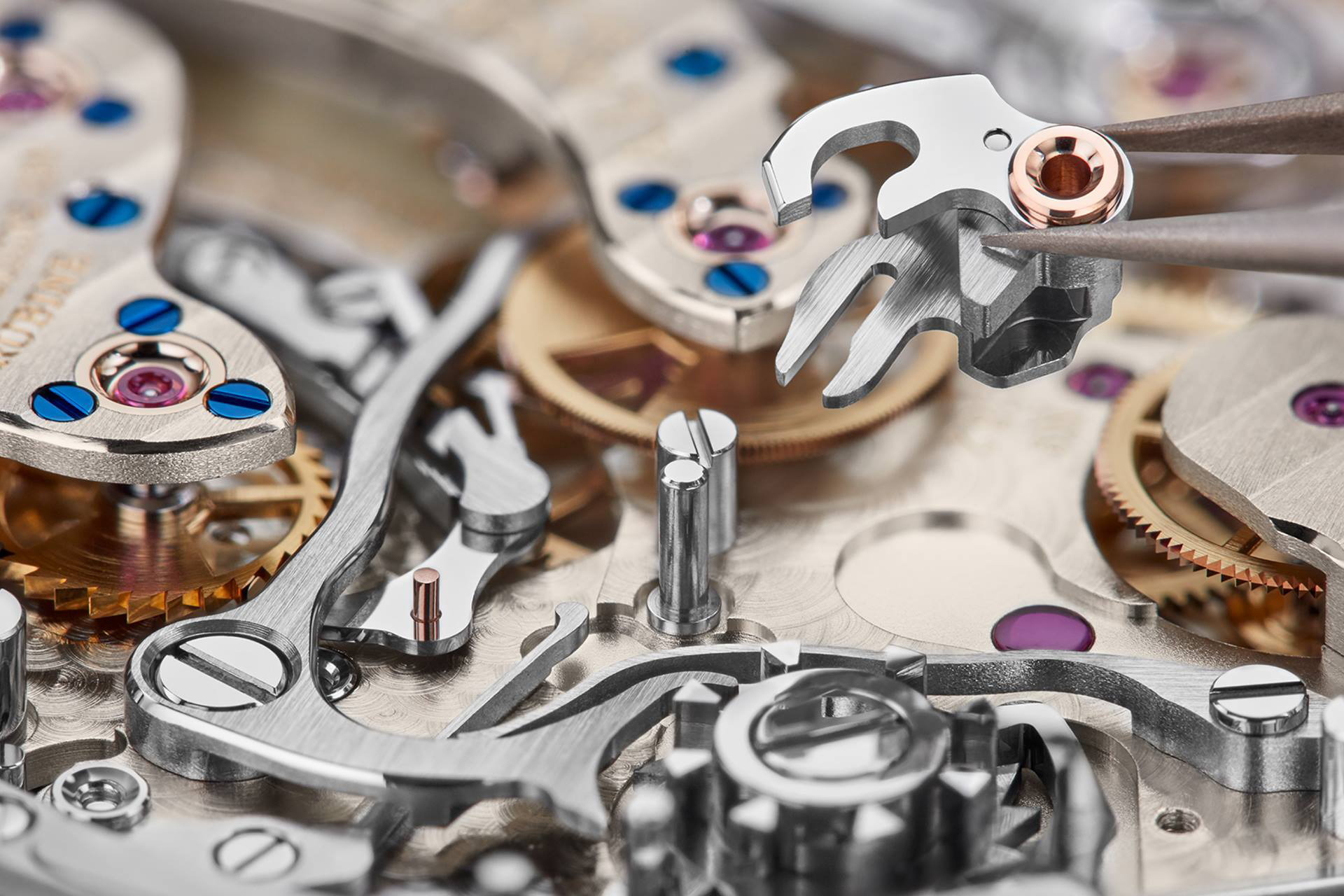
Little known though, the caliber L951.1 was not born perfect. In time, both due to functionality and longevity, the movement went through some drastic changes. When introduced in 1999, it was made of 390 parts but to my knowledge, that movement never came out to production due to some reliability issues – thus born the second generation L951.1 with 405 parts.
There are numerous changes between generations on levers, springs and jewels. The simplest identification between the L951.1 generations can be made via operating levers. The first, experimental version has a straight lever whereas the second and most common version has a curved one. The movements within Datographs are the second generation and was in production for about 8 to 10 years. The final version of L951.1 hence the Datograph can be found after 2007-2008 till 2012.
Caliber L951 Finishing & Architecture
When I asked how the Datograph looks so magnificent, elaborate and poetic (I’m biased as you see) to one of the prototype constructors of A. Lange & Söhne he replied:
“Well, it is more or less easy to make the levers straight, or bridges like square lumps sitting randomly… But, the watchmaking beauty is revealed when combined with aesthetics and that is the hard part for the designer and the watchmaker. Because, adjusting the tolerances with such delicate, angled parts are much harder compared to straight levers. However, this is what we do here and that is the only way we’re ever going to do it. Working on this movement to adjust tolerances, considering where to apply certain finish techniques and creating area for such applications give us more joy.
There is a dangerous temptation that every Lange owner can easily fall into: Wearing the watch case back up. Herein, caliber L951.1, makes a very, very strong case for such inducement. The three-dimensional construction of the movement brings an unrivaled depth; offering a myriad range of angles, finish techniques and new things to discover with every glance.
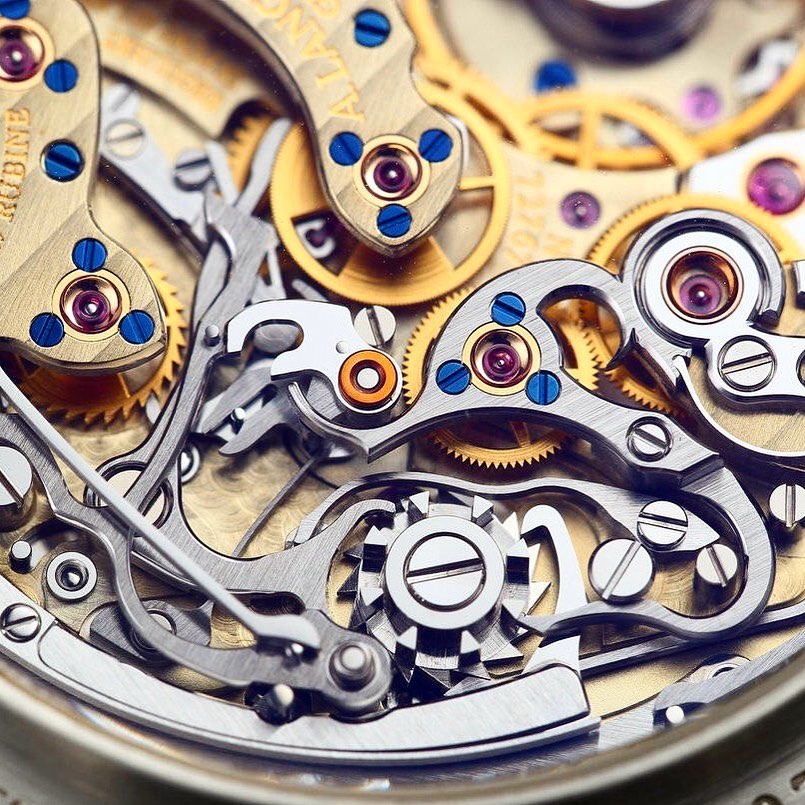
The base ¾ plate as well as the chronograph bridges are made of German Silver whereas the chronograph work is made of steel. The contrast created by the German Silver’s warm hue and steel’s cold grey is delightful. I was awe-struck upon observing the work going into each and every one of these pieces. In this 30 mms diameter area, one can find 9 different finishing techniques.
Steel levers carry linear finish on top, contour grinding on the sides and chamfering on the edges. Flyback lever and column-wheel are flat polished, resulting in a smooth, glossy surface. The wheels are endowed with circular graining to emphasize their functional nature. The German silver plates are striped. The clutch lever carries two brilliantly done inward angles and of course the base plate is finished with perlage.
Big brands – most of the time – polish most of the bevels by fast rotating, hand operated machine tools called touret. As they rotate thousands of times per minute, the process is much easier compared to complete manual hand-finish with files or wooden pegs. However, there is an area that these tools are useless: Sharp inward and outward corners. As if the caliber L951.1 was not awesome enough, it also delivers two direct proofs for the demanding handwork: Sharp inward corners and free-hand engraving.
Actually, after all these words of admiration and in-depth examination, Lange’s advertisement from 1999 perfectly encapculates what I am trying to reflect here:
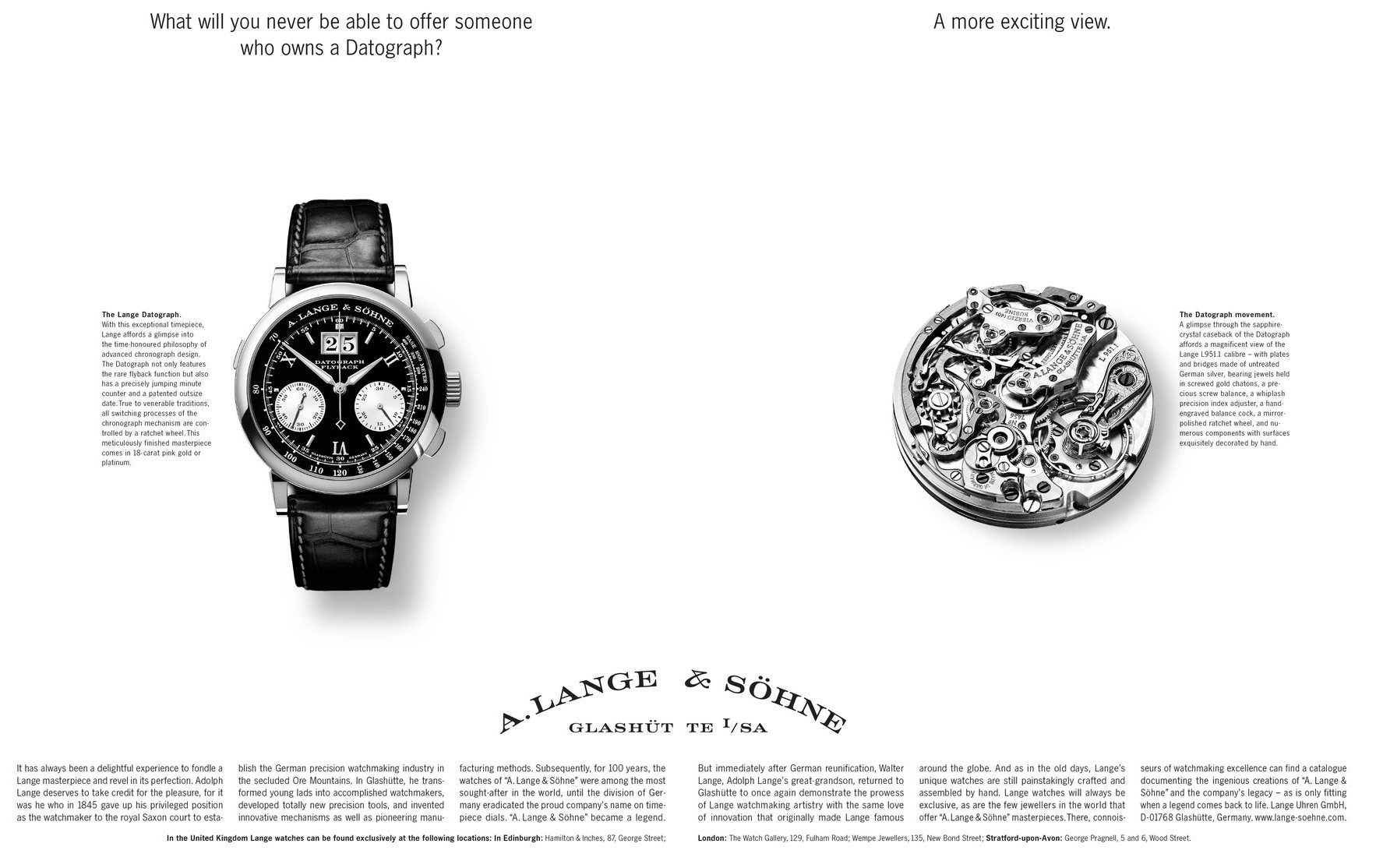
As a final remark; one of the most celebrated specs of the movement is its pusher feeling and I assure you, the fame is not for nothing. The engineering and watchmaker’s prowess goes into creating such a buttery-smooth experience is beyond me; yet the results are easily comprehensible. It is very consistent, impossible to activate on accident yet silky smooth when needed.
After almost 13 years of availability, Lange discontinued this modern grail in 2012 – only to breath new life into its successor.
Datograph Up/Down
The long awaited update to Datograph arrived in SIHH 2012: Datograph Up/Down. Here I must be clear that what I meant by long awaited is in terms of years; not in terms of production numbers. The model is currently available in platinum (405.035), pink gold (405.031) and to celebrate the 25th Anniversary, in the unofficial Lange livery white gold/blue dial (405.028).
Datograph Up/Down’s task is a monumental one. It came to replace one of the most recognized faces of the brand and I think even with some shortcomings, Lange did a great job on modernizing the Datograph.
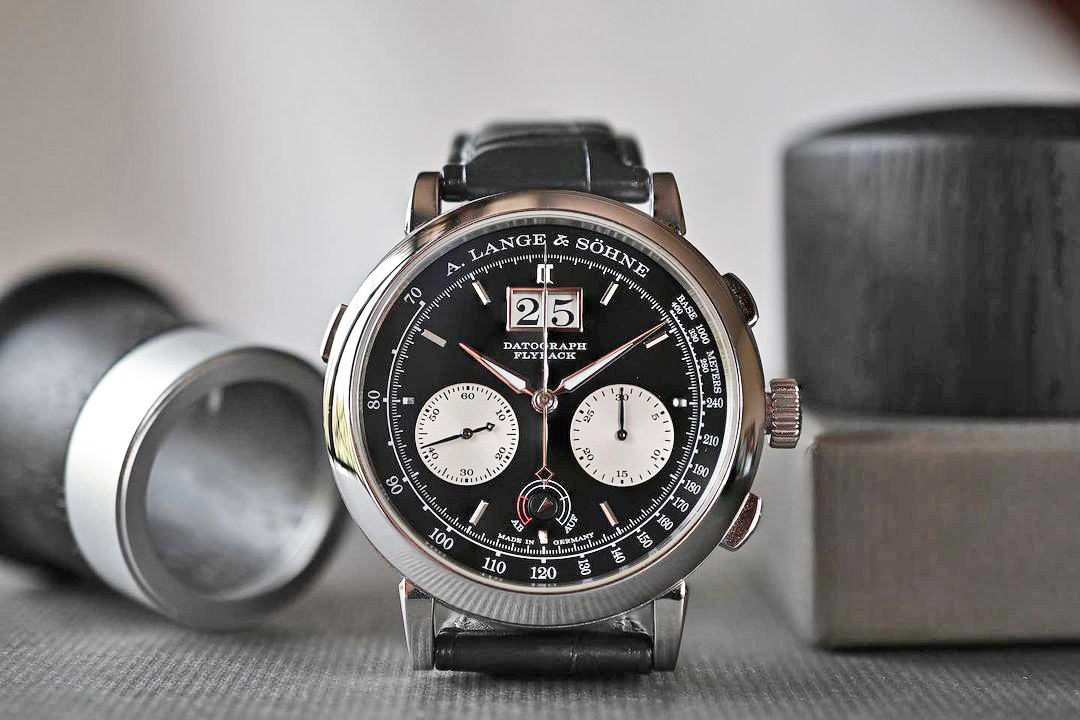
The Datograph Up/Down measures 41 mm in diameter and 13.1 mm in thickness. Which means it is 2 mms wider and 0.3 mms thicker than the first generation. However, it has a considerably better diameter / thickness ratio; hence, it sits better on the wrist. Moreover, the lugs are shorter in comparison to the original 39mm version. This detail also helps to beautifully balance the increased diameter.
Datograph Up/Down houses significant differences from the first generation both on the front and the back. Let’s start with the dial side:

The biggest changes on the dial are the removal of the Roman Numerals and the addition of the power reserve indication. Two changes I am not very fond of. As mentioned in the first generation Datograph section, in addition to adding a distinct and a strong character, Roman Numerals were creating a brilliant balance to the upper-centered focus point formed by sub-dials and the big-date. Unfortunately, Datograph Up/Down loses this balance due to the removal of the Roman Numerals. Albeit the arrangement results in a cleaner and a simpler look, it creates too much blank space, even more so with the increased dial diameter.
Another point is that without the Roman Numerals to balance out the rather crowded lower part, the gravity’s effect on the dial becomes more apparent. This in return causes the power reserve indication to hang by itself, without any balancing element.
Developing over and updating an icon is a tedious job. Because most of the time, no matter how good you do, there are going to be critiques, perhaps simply because we were so used to the original look, anything else feels off balance. All said and done, I think the brand accomplished a tremendous job and the Datograph Up/Down is a great part of our collecting lives for the last 13 years.
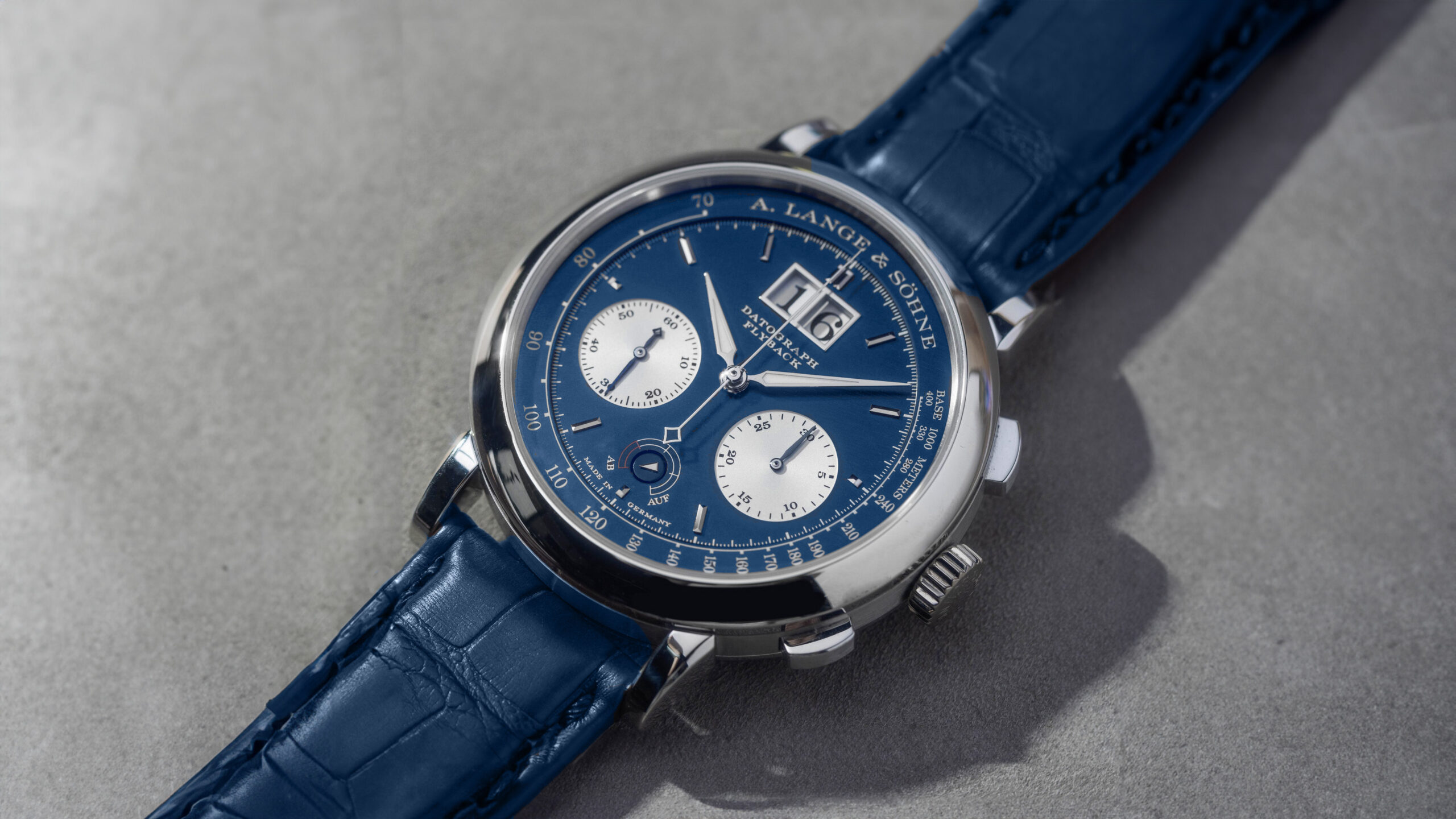
Datograph Up/Down 25th Anniversary in white gold with blue dial. Limited to 125 pieces.
Datograph Up/Down - Caliber L951.6
As a result of the modernization mission, Datograph Up/Down comes with an array of significant technical updates. Compared to its predecessor L951.1, the L951.6 is technically superior in every way and equally stunning in beauty.
With the removal of the maltese cross (limits the energy transfer below certain torque to make sure optimal timekeeping) on the mainspring barrel and a new thicker mainspring, Datograph Up/Down offers 60 hours of power reserve – a 24 hours increase from the previous generation.
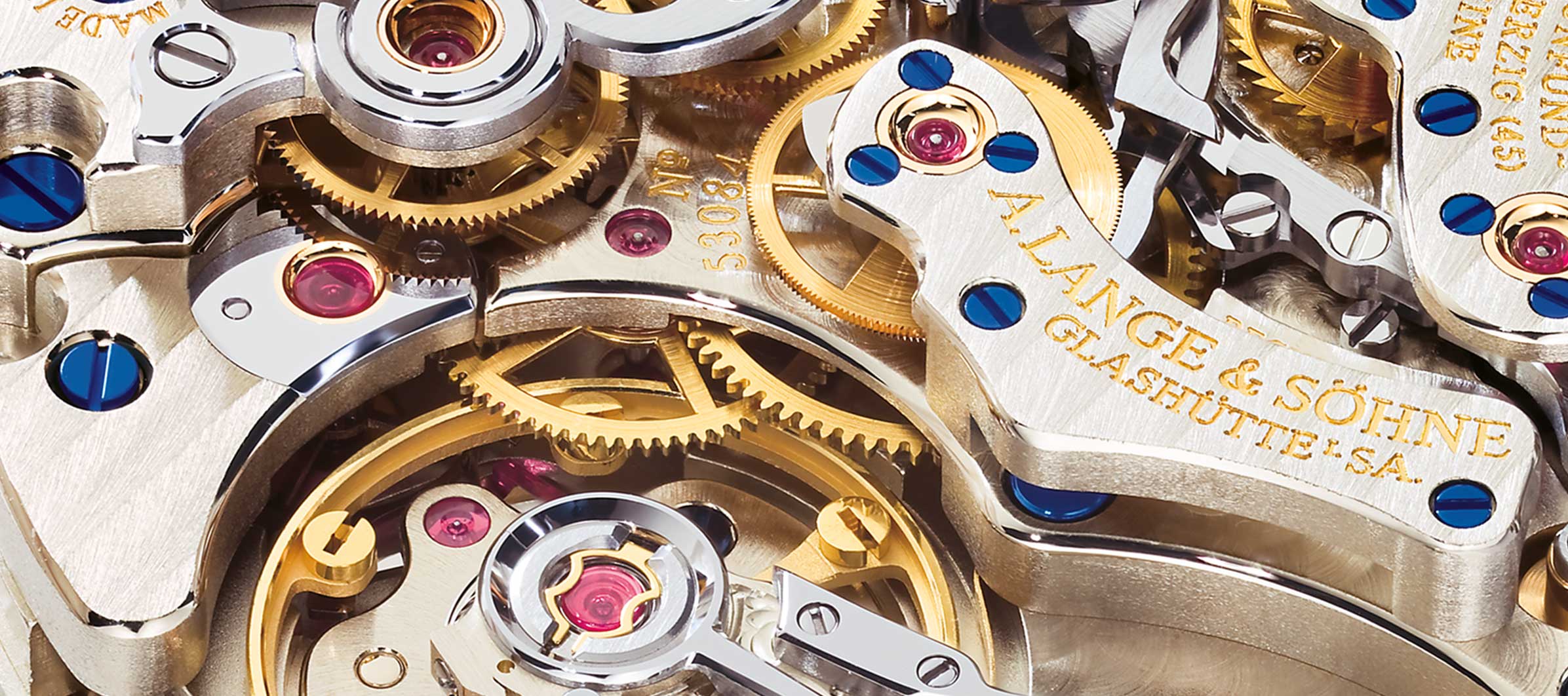
Moreover, instead of regulated balance, the updated L951.6 has an in house free-sprung balance with in-house balance wheel with overcoil – which in theory delivers much better performance compared to its predecessor. Also, A. Lange & Söhne states that the isochronism when the chronograph is actuated is much better compared to the previous generation.
Datograph Up/Down is a watch that is not fundamentally different from its predecessor – it does not need to be anyways. It incorporates small tweaks as a result of the changing design language of A. Lange & Söhne: Less baroque, more Bauhaus. Still very characteristic, and beautiful, just a bit less on both compared to the first generation, in my humble opinion.
I would like to finish up with a quote from the founder of Ming Watches – Ming Thein:
“In many ways, owning a Datograph represents the end of the line for this hobby”
Datograph is the embodiment of the watchmaking craft in an area of one’s palm. An eternal dance between engineering and aesthetics. Still, to many, it is the best chronograph ever made.
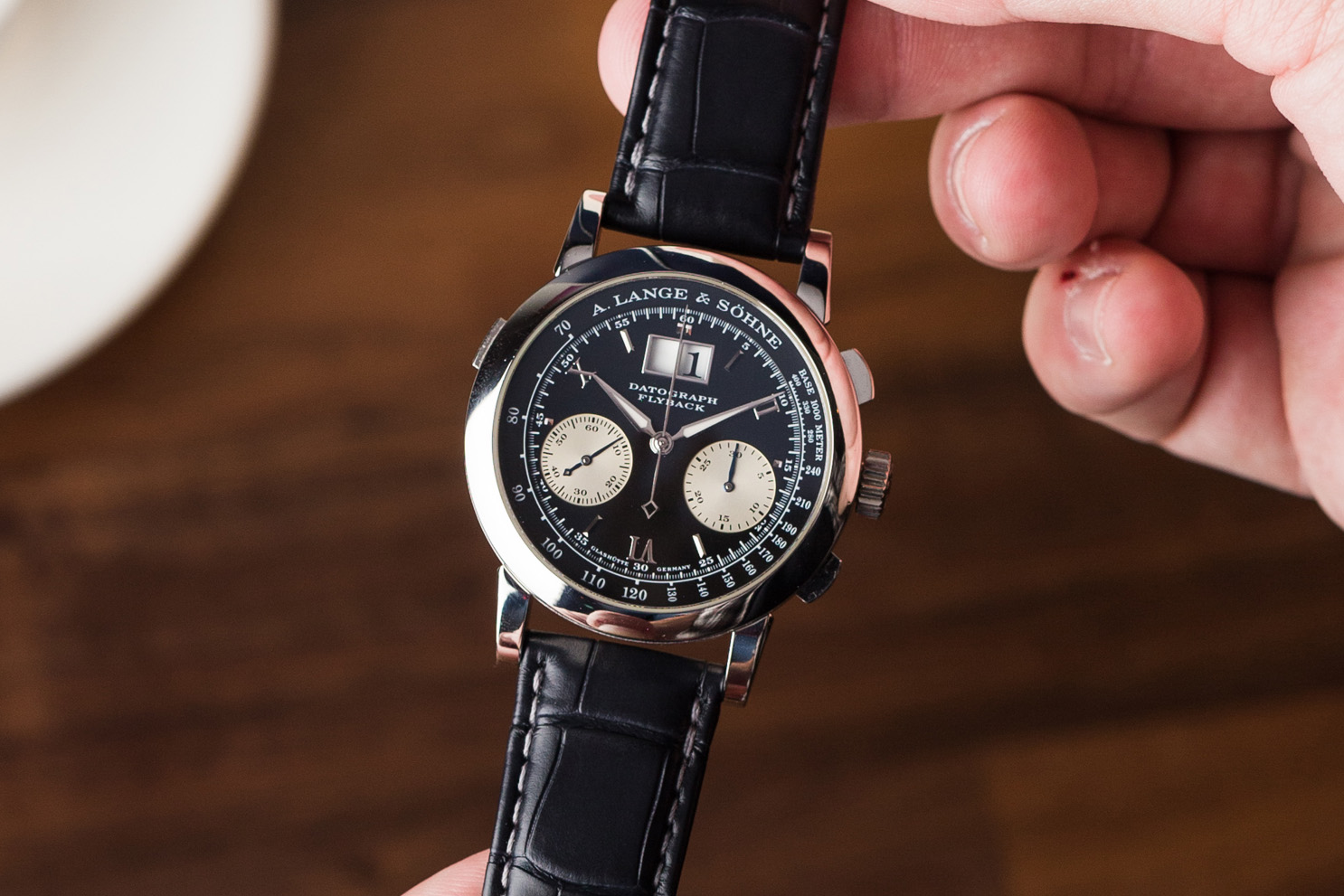
Die Traum Uhr. Courtesy of WatchBox.
Buying an A. Lange & Söhne Datograph
When I first penned this article in December 2021, I wrote the following:
“In the pre-owned market, the platinum first generation Datograph (403.035) is in the mid $70k, has gained a very solid traction since the first publishing of this article (it had been a year), and continues to do so. On the other hand, the Dufourgraph (403.031) asks noticable premium over its predecessor due to its scarcity. Good thing is that the pink gold / argenté dial (403.032) version is still flying under the radar and it can be found for a bit north of $60k.
Datograph Up / Down on the other hand, has a retail of $100k+ for the platinum (405.035) and $76,7k for the pink gold (405.031) version. Again, while in 2020, the secondary market for the models was offering a significant price advantage, the gap is closed significantly. Even the Up/Down editions now trade around $85-90k depending on the metal, set.
In conclusion: Surely the term “value” is utterly subjective for every collector. Yet, for a watch of this magnitude, historical importance, such value – especially in the second market is unbeatable.”
As of June 2022, the values above are nothing but a dream. Since then, the 403.035 appeared at auctions a couple of times and almost always sold above $100k – last one being in Phillips’ May auctions, at a whopping $160k. Thing is, the same reference with the same set (original box & papers) was available online for about 2 months at $110k and nobody bought it. As I’m writing this, it is still there for sale.
Therefore, I’d say that the realistic value for the Datograph (platinum) lies significantly less than the auction results, but much stronger than the $70k, written 7 months ago.
Datograph Up / Down on the other hand, especially in pink gold is a much better bargain than the other two as it sits in mid $70s, though objectively offers less collectability than its first generation sibling, which also reflects on the price.
All in all, Datograph is one of the watches that fully deserve every attention it gets, and I couldn’t be happier that this giant of watchmaking is finally getting the recognition.
Update April 2024: Datograph collection is significantly better than 5 years ago, and significantly worse than 2 years ago. We saw incredible prices with the rocketing interest, and as the attention cooled-down or spanned towards some other brands, the Datographs has become accessible once again, trading at around 75-85k range in platinum, depending on condition, set, metal.
Thank you.
I hope this was a valuable guide for whomever is looking for a Datograph model or just want to learn the details and history of these pieces. If you’d like to chat, sell or buy a Datograph, please kindly reach out to me via [email protected]
Please feel free to contact:
Follow Langepedia on Instagram:
Watch “A. Lange Story” Documentary, in partnership with WatchBox:
FAMILIES / COMPLICATIONS
STAY IN TOUCH
Sign up for the newsletter to get to know first about rare pieces at Marketplace and in-depth articles added to the encyclopedia, for you to make the most informed choice, and first access!